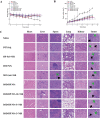Docetaxel prodrug and hematoporphyrin co-assembled nanoparticles for anti-tumor combination of chemotherapy and photodynamic therapy
- PMID: 36397301
- PMCID: PMC9848415
- DOI: 10.1080/10717544.2022.2147280
Docetaxel prodrug and hematoporphyrin co-assembled nanoparticles for anti-tumor combination of chemotherapy and photodynamic therapy
Abstract
To realize the synergistic anti-tumor effect of chemotherapy and photodynamic therapy, the mono sulfide-modified docetaxel (DTX) prodrugs (DSD) provided by our laboratory and hematoporphyrin (HP) were used to physically prepare co-assembled nanoparticles (DSD/HP NPs) by nano-precipitation. For the first time, this study showed its characteristics, in vitro anti-tumor activity, pharmacokinetic behavior in rats, in vivo distribution, and pharmacodynamic effects on 4T1 tumor-bearing Bal b/c mice. DSD/HP NPs optimized by single-factor and response surface optimization had several distinct characteristics. First, it had dark purple appearance with particle size of 105.16 ± 1.24 nm, PDI of 0.168 ± 0.15, entrapment efficiency and drug loading of DSD and HP in DSD/HP NPs of 96.27 ± 1.03% and 97.70 ± 0.20%, 69.22 ± 1.03% and 20.03 ± 3.12%, respectively. Second, it had good stability and could release DTX and HP slowly in the media of pH 7.4 PBS with 10 mM DTT (H2O2). Moreover, DSD/HP NPs along with NiR treatment significantly inhibited 4T1 cells proliferation, and induced more reactive oxygen species and cells apoptosis. In vivo pharmacokinetic and pharmacodynamic studies showed that DSD/HP NPs could prolong the drug circulation time in rats, increase drug distribution in tumor site, obviously inhibit tumor growth, and decrease the exposure of drug to normal tissues. Therefore, DSD/HP NPs as a promising co-assembled nano-drug delivery system could potentially improve the therapeutic efficiency of chemotherapeutic drug and achieve better anti-tumor effects due to the combination of chemotherapy and photodynamic therapy.
Keywords: Docetaxel prodrug; chemotherapy; co-assembled nanoparticles; hematoporphyrin; photodynamic therapy.
Conflict of interest statement
No potential conflict of interest was reported by the authors.
Figures







Similar articles
-
Anticancer efficacy of photodynamic therapy with hematoporphyrin-modified, doxorubicin-loaded nanoparticles in liver cancer.J Photochem Photobiol B. 2014 Nov;140:49-56. doi: 10.1016/j.jphotobiol.2014.07.005. Epub 2014 Jul 24. J Photochem Photobiol B. 2014. PMID: 25090224
-
Co-delivery of Docetaxel and Disulfonate Tetraphenyl Chlorin in One Nanoparticle Produces Strong Synergism between Chemo- and Photodynamic Therapy in Drug-Sensitive and -Resistant Cancer Cells.Mol Pharm. 2018 Oct 1;15(10):4599-4611. doi: 10.1021/acs.molpharmaceut.8b00597. Epub 2018 Sep 7. Mol Pharm. 2018. PMID: 30148955
-
Stimuli-responsive heparin-drug conjugates co-assembled into stable nanomedicines for cancer therapy.Acta Biomater. 2023 Jul 1;164:422-434. doi: 10.1016/j.actbio.2023.04.016. Epub 2023 Apr 22. Acta Biomater. 2023. PMID: 37088159
-
Co-delivery of docetaxel and gemcitabine by anacardic acid modified self-assembled albumin nanoparticles for effective breast cancer management.Acta Biomater. 2018 Jun;73:424-436. doi: 10.1016/j.actbio.2018.03.057. Epub 2018 Apr 9. Acta Biomater. 2018. PMID: 29649635
-
Oxygen-producing catalase-based prodrug nanoparticles overcoming resistance in hypoxia-mediated chemo-photodynamic therapy.Acta Biomater. 2020 Aug;112:234-249. doi: 10.1016/j.actbio.2020.05.035. Epub 2020 Jun 2. Acta Biomater. 2020. PMID: 32502633
Cited by
-
Nanostructures for site-specific delivery of oxaliplatin cancer therapy: Versatile nanoplatforms in synergistic cancer therapy.Transl Oncol. 2024 Jan;39:101838. doi: 10.1016/j.tranon.2023.101838. Epub 2023 Nov 27. Transl Oncol. 2024. PMID: 38016356 Free PMC article. Review.
References
MeSH terms
Substances
LinkOut - more resources
Full Text Sources
Other Literature Sources
Medical
Research Materials
Miscellaneous
